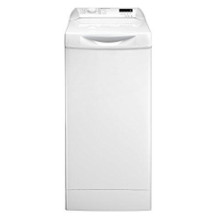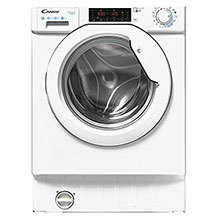Tumble dryer purchasing advice: how to choose the right product
- What you need to know
- Tumble dryers are a quick and space-saving alternative to clothes lines. However, they need electricity to work.
- Condenser tumble dryers are cheap to buy but expensive to run. Modern heat pump dryers are more expensive initially but are much more energy efficient and cheaper to run in the long term.
- If you don’t have room for a freestanding front-loading dryer, there are also narrower top-loading models and ones that can be built into cabinets.
- One of the most important factors when it comes to choosing a tumble dryer is its capacity. You need the right size otherwise you will waste electricity.
- Unlike washing machines, the capacity of a tumble dryer refers to damp rather than dry laundry.
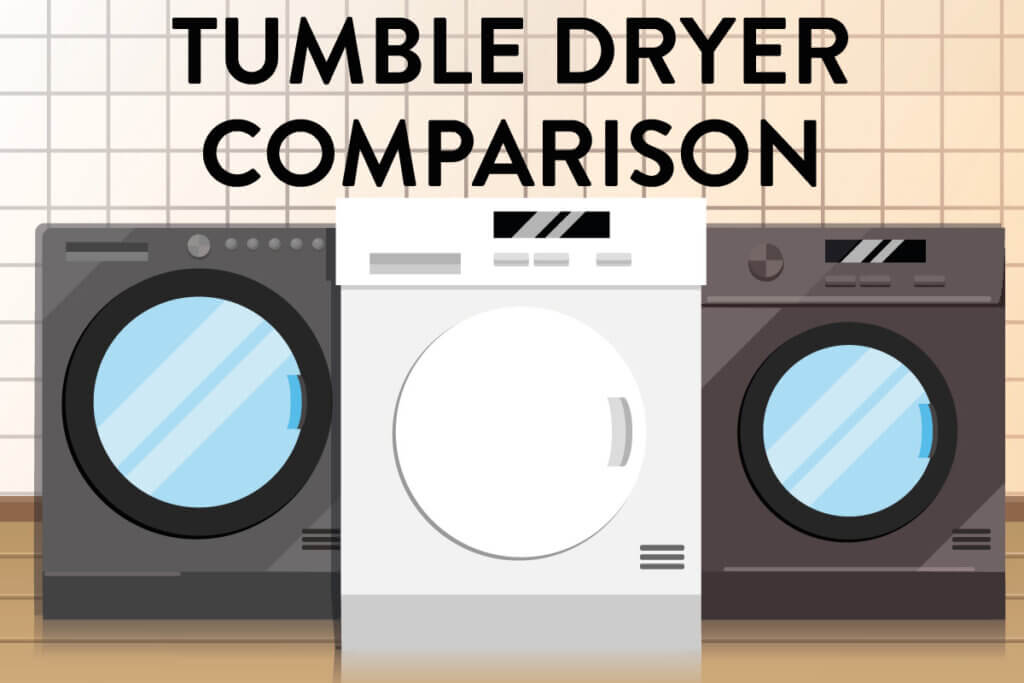
Dry whatever the weather
While drying your washing on a clothesline is by far the most economical way to do your laundry, sometimes it just isn’t an option. Space can be limited on balconies and drying your clothes outside when it’s wet and cold isn’t going to work.
You can of course use a drying rack inside your home, but the moisture that comes off your wet laundry can cause a buildup of moisture in your walls, resulting in mold. Tumble dryers offer a quick and space-saving solution to this problem. They are extremely easy to use — no more time wasted hanging up and taking down your washing. The flipside of course is that tumble dryers need electricity to work. However, depending on the model, you can get some quite energy-efficient machines. Read on for an overview of the types of tumble dryer available on the market, to help you make the right decision.
Advantages
- Space-saving
- Quick drying
- No need to hang up laundry
- Drying regardless of the weather
Disadvantages
- Need electricity to work
- More expensive than clothes lines and drying racks
Types of tumble dryer
There are a few different types of tumble dryers on the market. These differ in terms of their drying technology, and their respective purchase prices and running costs. The two most common types are condensation and heat pump tumble dryers. Nowadays, you rarely see exhaust air dryers — their technology is pretty outdated. You can also get combination washer-dryers which combine a washing machine with a tumble dryer. Read on for an overview of these types, with a special focus on condensation and heat pump models.
Exhaust air
Also known as vented dryers, these tumble dryers are the predecessor to heat pump and condensation models. Instead of pumping the moisture in your laundry into a tank by condensing it from heated air, these tumble dryers pump the warm excess humid air outside. You need to connect these tumble dryers to a vent outside using an exhaust hose. If not, the excess humid air can cause a buildup of moisture in your home, which will cause mold to grow.
Due to the need for an exhaust hose and outlet, it can sometimes be difficult to find a suitable location for this type of tumble dryer. By comparison, heat pump and condensation tumble dryers only need a power socket. In addition, this type of tumble dryer consumes a lot of electricity. As a result, they are quite rare nowadays.
Advantages
- Cheap initial purchase price
- Quick drying
Disadvantages
- High power consumption
- Exhaust hose leading outside necessary
- Rarely sold nowadays
Condensation
Warm air can hold much more moisture than cold air. This means you can use warm air to extract moisture from your wet laundry. Tumble dryers work using this principle.
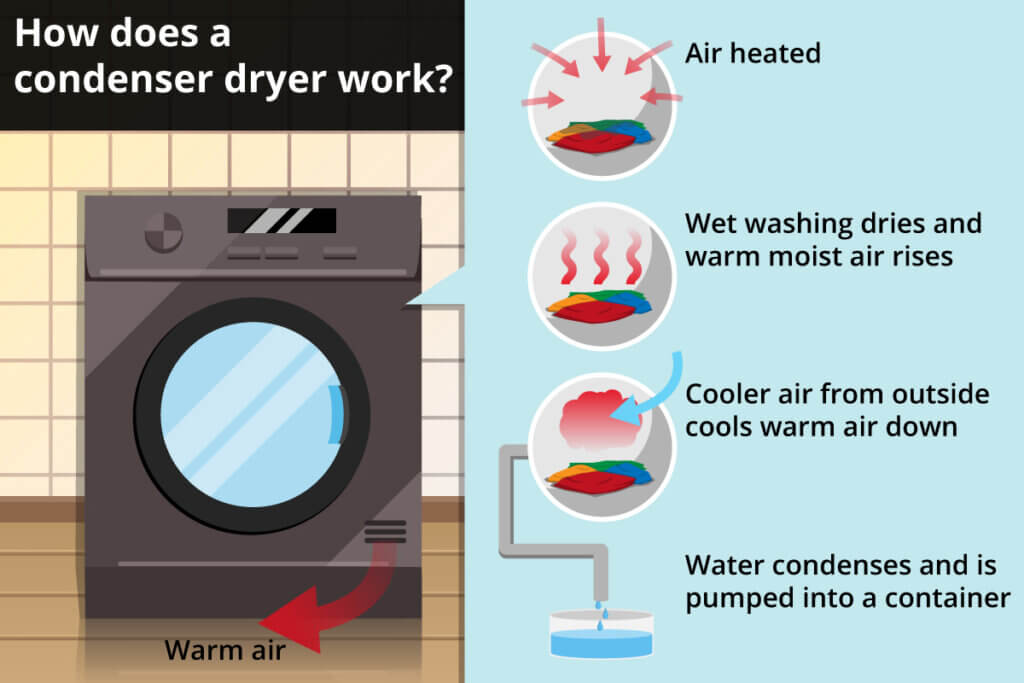
Condensation dryers heat up the air inside them so that it takes the moisture out of your laundry and into the air. Compared to exhaust air tumble dryers, condensation dryers don’t have an exhaust hose. Instead, the resultant warm humid air is cooled and the water that condenses is then pumped into a tank. Since they use cold air to condense this water, condensation dryers work best in cold ambient temperatures.
The warm air that is left over from the condensation process is then released into the room. During the winter, this can be quite pleasant and can save on some heating costs. However, on warmer days the heat that comes out of a condensation dryer can be quite unpleasant. Moreover, the dryer will need to use more energy to cool the warm humid air inside.
The process of heating and condensing is repeated several times during drying until your laundry has the desired moisture level. The amount of times this happens depends on how wet your laundry is, and how dry you want it to be.
Use water sensibly
Of course, you can just dispose of the condensed water by pouring it down your toilet or your sink. However, if you want to be more environmentally friendly, consider using it to water your plants.
Condensation dryers are comparatively inexpensive to buy. Most models cost between $200 and $600. The catch is that they use a lot of electricity due to the heating and cooling process and are therefore quite expensive to run. If you live in a big household, you can expect a relatively high energy bill. More detailed information on electricity consumption can be found at the end of this section.
Advantages
- Cheap to buy
- Quick drying
- No exhaust vent necessary
Disadvantages
- High energy consumption
- Not suitable for drying delicate textiles
- Effectiveness depends on ambient temperature
- Produces waste heat
Heat pump
Heat pump tumble dryers are a more modern and energy-saving version of condensation dryers. They have a special feature which means that the warm exhaust air doesn’t get released into the environment. Instead, it gets pumped back in and used to repeat the heating and cooling process. In order to do this, heat pump dryers use a refrigerant which extracts the heat from the exhaust air and stores it ready to be reused.
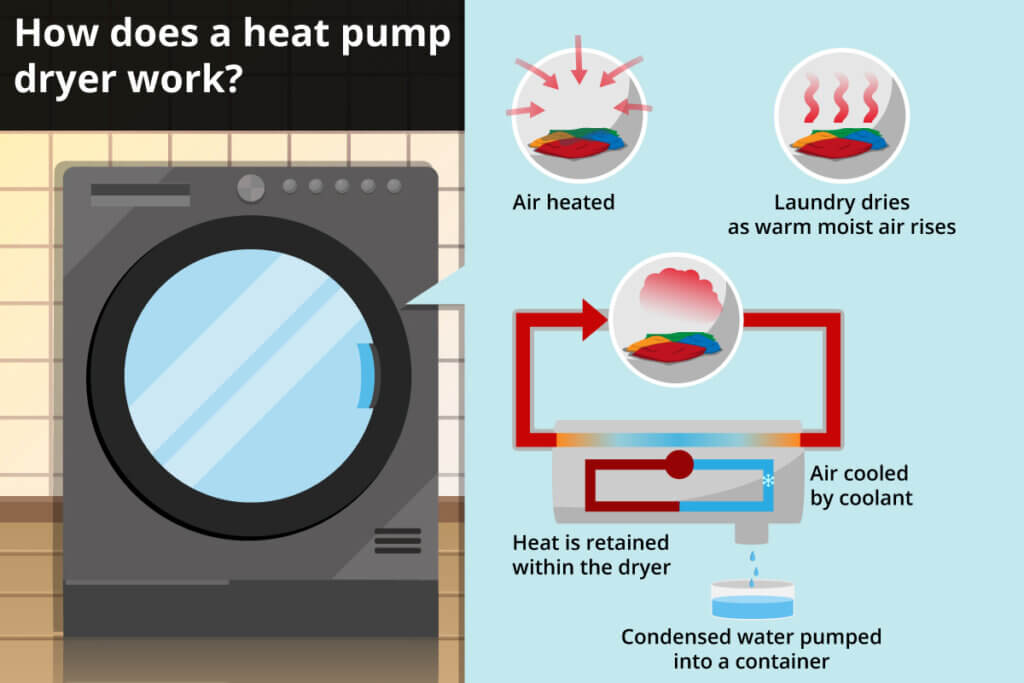
Compared to condenser dryers, heat pump dryers don’t release any unused energy into the environment. This makes them much more energy efficient. Depending on the model, heat pump dryers can be up to 50% more efficient than standard condenser dryers. Drying often takes a little longer than with condenser dryers, as heat pump models work at slightly lower temperatures. The flipside to this is that the drying process is gentler, meaning you can use them to dry delicate fabrics.
Caution during disposal
When your heat pump dryer is at the end of its service life, you need to dispose of it properly. The refrigerant inside can be harmful to the environment if you don’t.
Nowadays, heat pump dryers have become a lot more affordable compared with condensation dryers. Nevertheless, you will have to pay a bit more for these energy-efficient machines. Prices tend to start at around $500, so you should budget at least $600 for a good model.
Advantages
- Extremely energy efficient
- No exhaust air
- Works in any location
- Gentler drying
Disadvantages
- Higher initial purchase cost
- Slightly longer drying times
Two-in-one: washer-dryers
Combination washer-dryer machines are a great way to save space, and are usually cheaper than buying a separate washing machine and tumble dryer. However, they do come with a few disadvantages. For example, the maximum load for washing clothes is much more than for drying clothes. This means you’ll have to take some of your wet laundry out before starting a drying cycle and then repeat it afterwards. This can result in some quite high energy costs.
Advantages
- Space-saving
- No need to reload your laundry
- Cheaper than two individual units
Disadvantages
- High electricity and water consumption
- Less capacity when drying than when washing
- Relatively small product selection
What dryer should I buy?
If you need a new washing machine as well as a tumble dryer, you should consider a combination washer-dryer. If you already have a washing machine, you need to choose between a heat pump and a condenser model. In other words, you need to choose between lower running costs or lower initial purchase price.
The difference in economics depends largely on how often you use your tumble dryer. For example, if you’re living by yourself, a condenser dryer makes more sense. For families that do a lot of laundry, making the investment in a heat pump dryer can be really worthwhile. As a basic rule, the more laundry you do, the quicker a heat pump model will pay for itself over time. The following graph shows this.
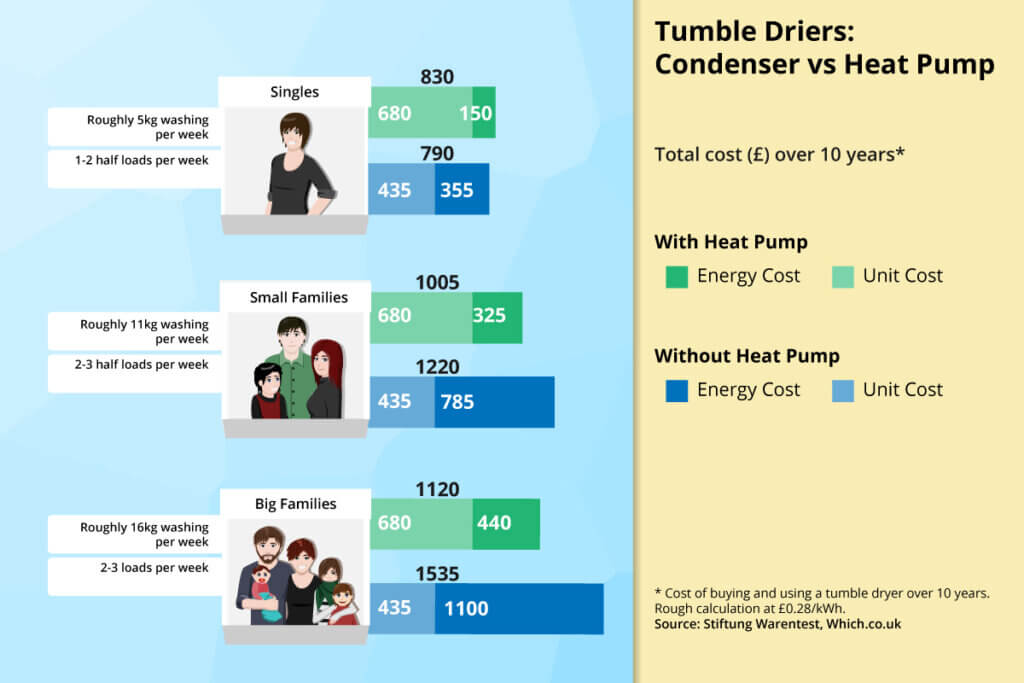
How to choose the right dryer
In addition to choosing the right kind of drying technology, there are a few other things you need to consider when making a purchase. You need to ask yourself the following questions:
- What sort of drying capacity do I need?
- Where am I going to put the dryer?
- Do I have enough space for a freestanding unit or do I need something more compact?
- Do I want a front or top loading model?
Capacity
One of the most important things to consider is the capacity of your potential tumble dryer. This is also known as load or fill quantity. It determines the maximum weight of wet laundry that can be dried in one cycle. This information can be found from the manufacturer. One thing to note is that capacity on tumble dryers refers to wet laundry, whereas for washing machines it refers to dry laundry. This means that if you have two machines (or a combination machine) with the same capacity, you won’t be able to put a full load from the washing machine into the tumble dryer as the wet weight will be too high.
Making the right choice saves you cash
Choosing a dryer with the right capacity is extremely important as it will affect your running costs. If the capacity is too small, you’ll have to run several cycles which consumes more energy. If the capacity is too large, you will end up wasting energy and money.
Which capacity do I need?
Basically, the capacity you need depends on two factors:
- Household size
- Laundry volume
There are a lot of models on the market with a capacity of 15 to 17 pounds (7-8kg). However, there are also smaller models with capacities of around 6 pounds (3kg), and extra large ones with a capacity of 17 pounds (8kg) or more. The following table provides a little guidance:
| Household size | Laundry volume | Recommended capacity |
| Single | Low to medium | 6-13 lb (3-6kg) |
| 2-3 people | High | 13-15 lb (6-7kg) |
| More than 3 people | High | 17 lb or more (8kg) |
Location
Depending on the technology, different dryers are suitable for different locations. Exhaust air dryers need to be in a place where their exhaust hose can connect to a vent that goes outside. Condensation and heat pump dryers don’t need this, but condensation dryers shouldn’t be placed where their exhaust heat is disturbing.
Design
Front-loading dryers can be further differentiated according to their design into freestanding, column-mounted, and under-mounted models. The special features of the three types are explained in the following overview:
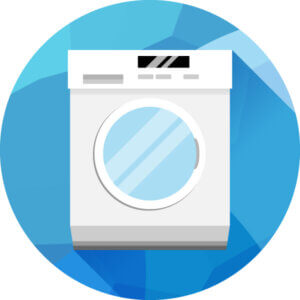
Freestanding
Classic front loading tumble dryers are freestanding machines. You need to have sufficient floor space, but otherwise they can be installed anywhere there is a power socket nearby. You can also use the top of the machine as a storage space. Standard freestanding dryers are about 23 inches wide (60cm), 33 inches high (85cm), and 23 inches (60cm) deep.
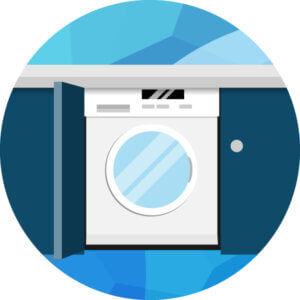
Integrated
Heat pump dryers don’t emit any heat, so you can install them in your kitchen if you want. Inbuilt models have a removable top plate which means you can install them underneath counter tops. To protect the internal components, these models have a plate you screw on instead of a top plate.
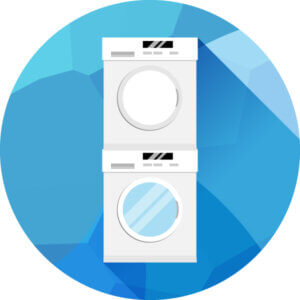
Column-mounted
If you don’t have enough space next to your washing machine for a freestanding model, you can also get a column-mounted dryer. These are designed so you can put them on top of a washing machine and make use of the height of a room. The only important thing to note is that they need to be smaller than the washing machine you want to put them on. You will also need an attachment to ensure that both appliances are stable.
Column attachments
The stands you need for attaching a column-mounted dryer to a washing machine are widely available. Sizes are often standardized, which means you can use appliances from two different manufacturers. However, manufacturer-specific attachments are often best if you have compatible machines.
Front or top loading?
Just like washing machines, tumble dryers come in front and top loading models. Top loading models are usually narrower than front loading ones, which can be a good option if you are limited for space.
Functions
Depending on the model, tumble dryers come with various features. Read on for a quick overview.

Display
Most dryers now come with a display to show which program is running and how long is left. Some models will also show if you need to empty the condensation tank or clean out the lint filter.
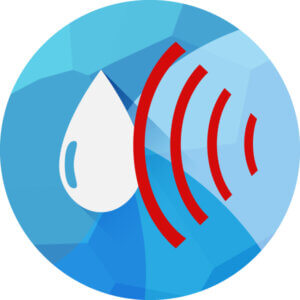
Humidity sensors
A lot of modern tumble dryers can sense the moisture level of your laundry and change their run time accordingly. Once your washing is dry, the machine will automatically turn itself off. This is a useful feature as it can prevent your laundry from over drying and shrinking.

Automatic volume control
Some models can sense how large and wet your laundry is and automatically adjust the cycle duration and energy consumption to match.
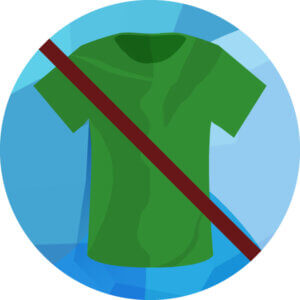
Crease protection
If you’re unable to remove your laundry directly after drying, a crease protection function can be useful. This turns on automatically and gently spins your laundry from time to time to prevent it from becoming creased.

Gentle drum
Some tumble dryers have gentle honeycomb drums. As you might have guessed, they have a honeycomb-like structure which is gentler on your laundry as it spins.
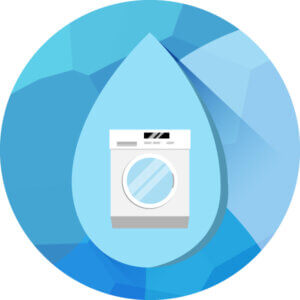
Self-cleaning
Condensation water tanks need to be regularly emptied. This can be quite time consuming. A lot of modern dryers have a self-emptying container, which saves time.

Start and end time preselection
This feature lets you set when you want the drying cycle to start or end. This means you can set your washing to be dry by the time you get home.
Different programs
Not all laundry is the same. Some fabrics are much more delicate than others. As a result, all tumble dryers come with different programs depending on what you are drying. These can include:
- Gentle silk or wool programs for delicate textiles.
- Easy-care for drying delicate textiles at a lower temperature and with fewer spins.
- Eco programs for energy-saving drying at lower temperature with longer running time.
- Short programs for quick drying in 30 or 45 minutes.
- Refresh cycle to air the laundry and remove odors and lint.
- Extra dry for non-sensitive textiles such as jeans or towels that need to become very dry.
- Cupboard dry for lighter textiles made of cotton or linen, not suitable for jeans.
- Ironing damp for ironing laundry that needs a certain residual moisture.
Usage tips
Not all textiles are suitable for tumble drying. There are usually care symbols on labels to indicate this. A circle within a square indicates that a textile can be put in a tumble dryer. If there is a cross through it, then it cannot be machine dried. Dots within the circle indicate temperature. One dot means that the fabric is delicate and shouldn’t be washed at a high temperature. Two dots mean that the fabric can be washed at high temperatures.
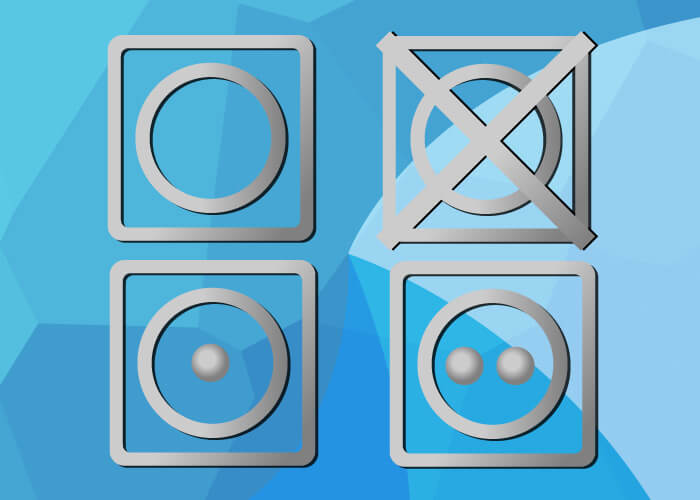
Dryer balls
Dryer balls are made from plastic and look a bit like massage balls. If you put them in with your laundry, they can help improve air circulation. This can speed up drying time by up to 25%. Dryer balls are particularly good for drying down jackets, pillows, and blankets, as they prevent the feathers from clumping together.
If you don’t want to use fabric softener, but you do want your laundry to be soft and fragrant, consider using dryer sheets. They have an antistatic effect which ensures your laundry stays soft. They also can contain aromas to make your laundry smell good.
Five tips for energy-efficient drying
When choosing a tumble dryer, you should go for a model that is as energy efficient as possible. You can also save electricity by following these five tips:
- Spin the laundry at as high a speed as possible: this reduces the residual moisture and shortens the drying process.
- Clean the tumble dryer regularly: dirt in the dryer prolongs the drying time and increases electricity consumption. You should clean the lint filter after every time you use your tumble dryer.
- Use the full capacity: if the drum is only half full, the dryer will use more electricity than necessary. Ideally, always fill your tumble dryer to capacity.
- Eco program instead of short program: If you have enough time, use a slower but eco-friendly program.
- Use dryer balls: they stir up your laundry as it spins which speeds up the drying process.
Images 1-15: © FinalCheck

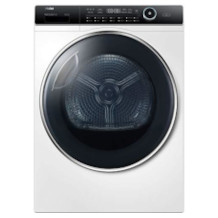
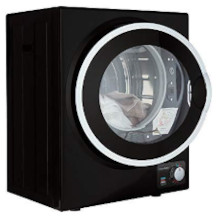
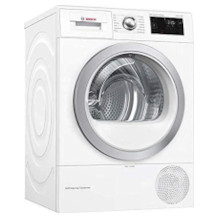
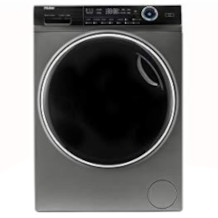
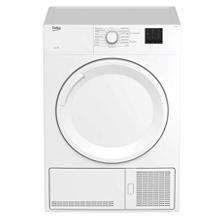

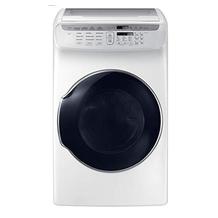
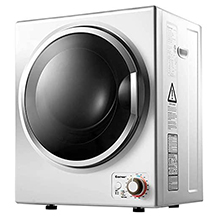

 no reviews
no reviews
